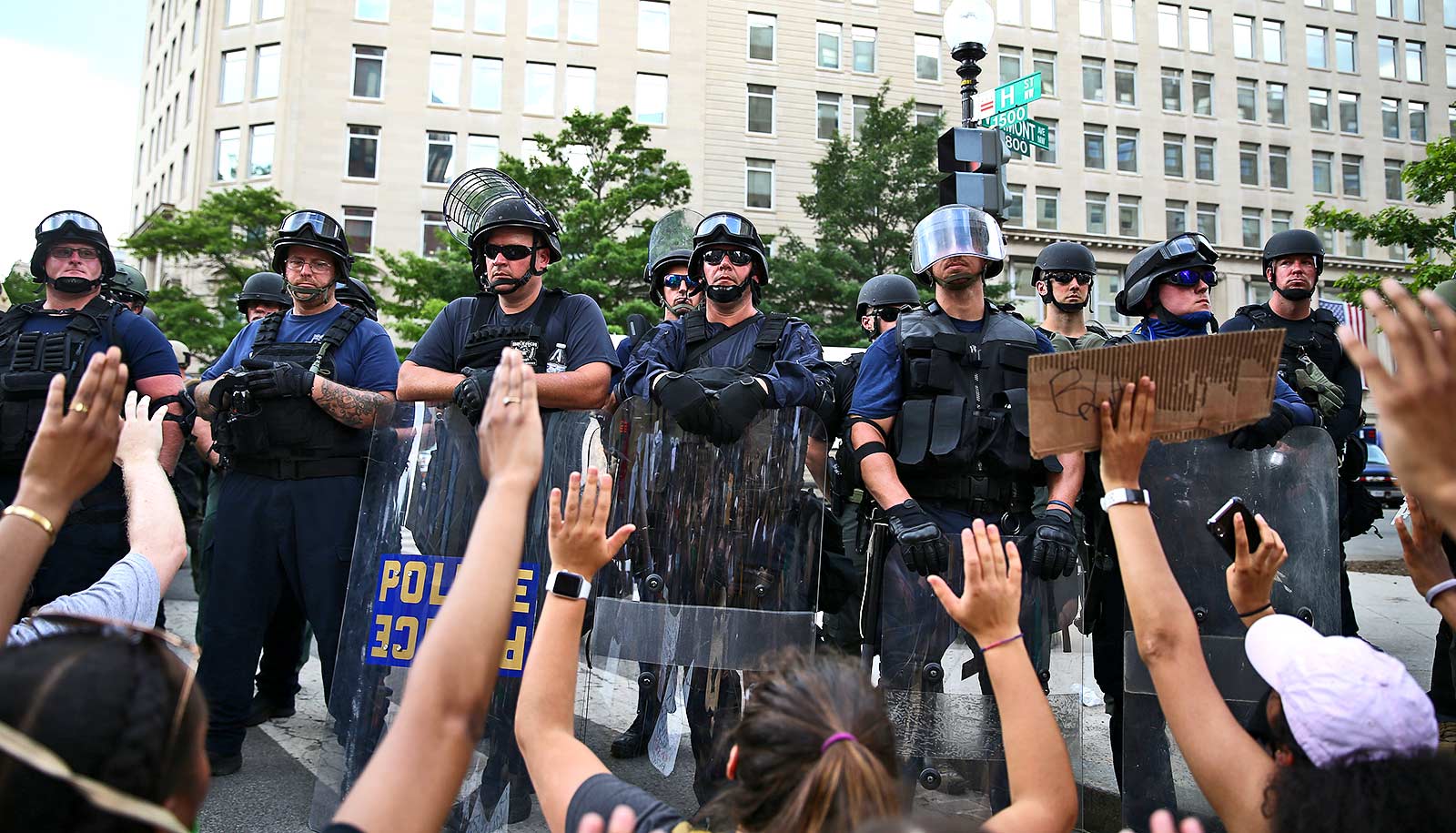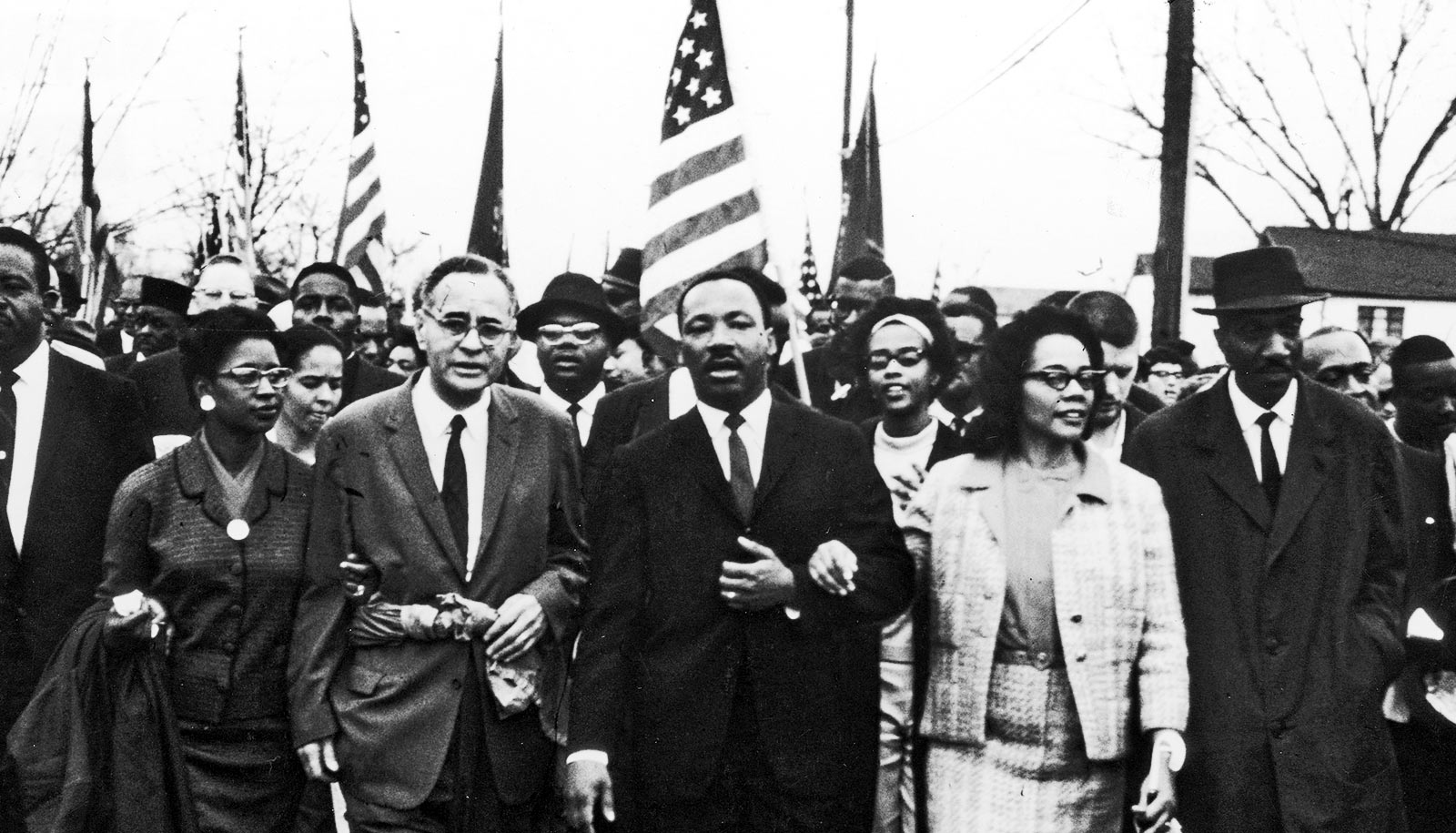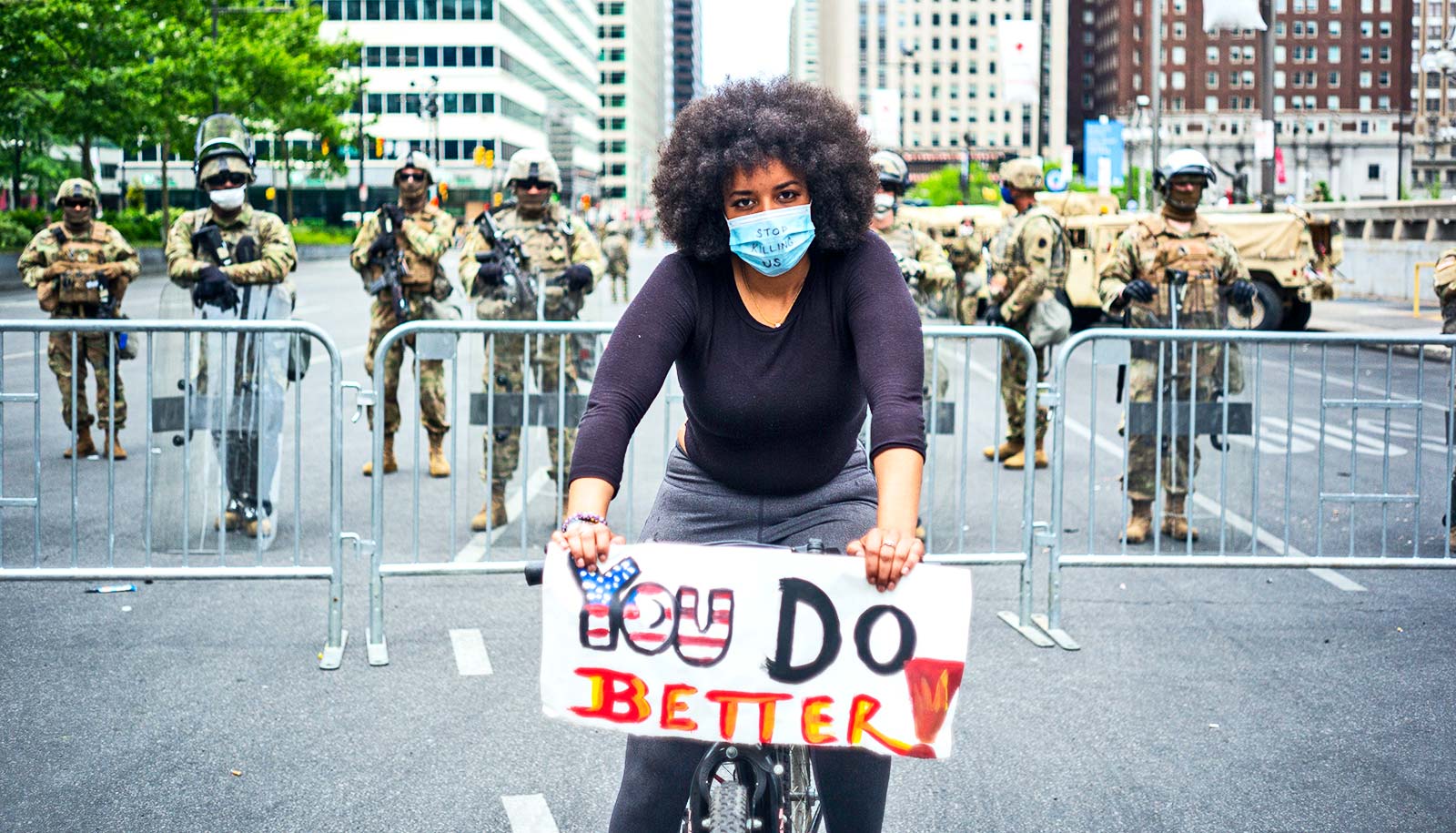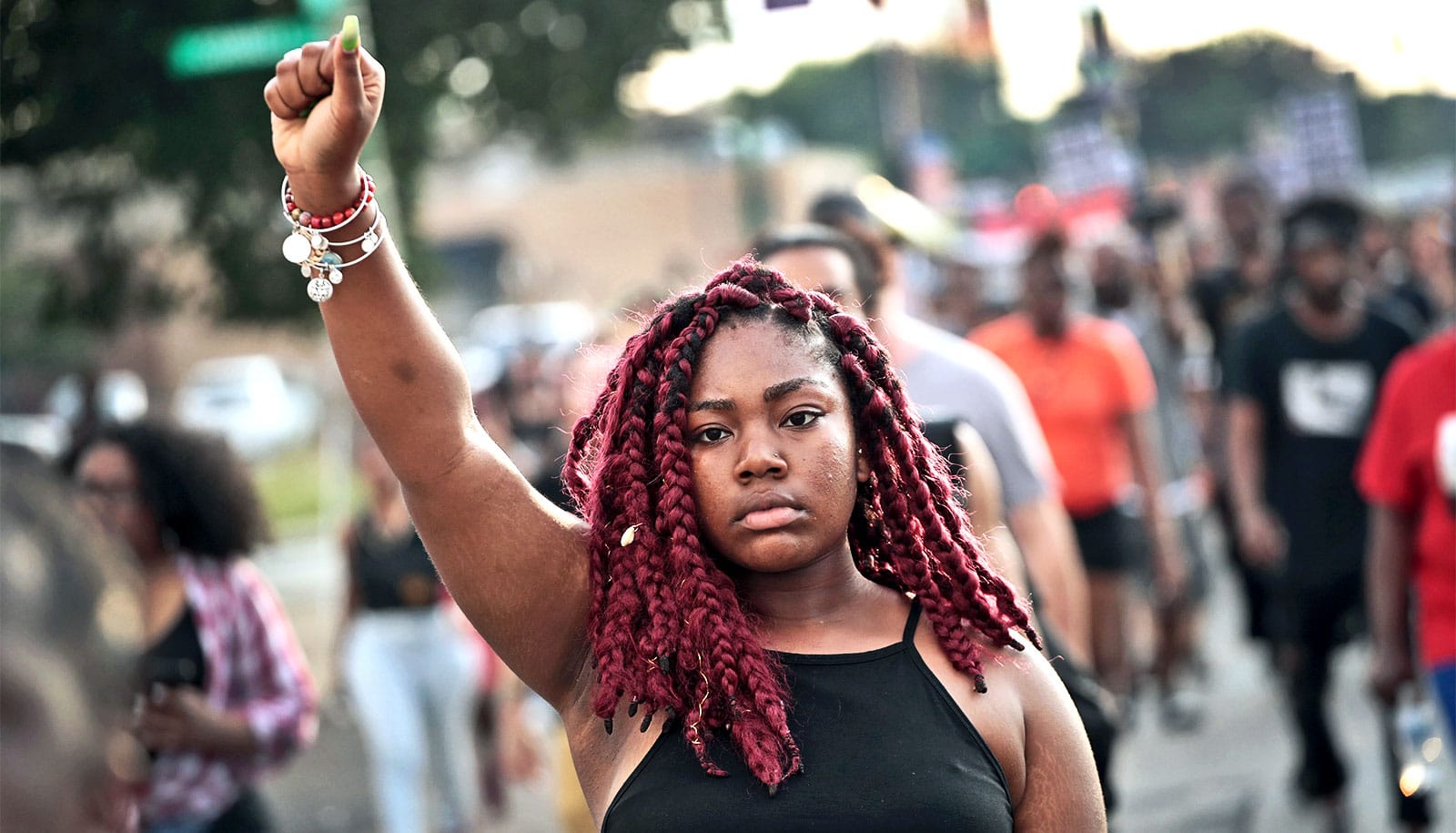Legal experts explain the avenues for police reform and challenges in the way.
Horrifying images of George Floyd dying on a Minneapolis street while a police officer knelt on his neck have sparked peaceful protests and rioting throughout the country.
The latest in a string of killings of unarmed black Americans, the incident once again raises questions about training and the use of force by police and the ability of prosecutors to hold police accountable.
Here, Ron Tyler, professor of law and director of Stanford Law’s Criminal Defense Clinic, and Suzanne Luban, clinical supervising attorney and lecturer in law, discuss the Floyd case and offer suggestions for a way forward:
The four officers involved in George Floyd’s detainment and death were fairly quickly fired from the Minneapolis Police Department. On May 29, officer Derek Chauvin was charged with third-degree murder and second-degree manslaughter in the killing of Floyd. What’s the latest on charging?
Tyler: The case changed dramatically as of June 3. The Attorney General of Minnesota took over the prosecution from the Hennepin County Attorney’s Office on June 1. Two days later, the AG completely changed the stakes. Derek Chauvin now faces three charges: 2nd degree felony murder, 3rd degree murder, and 2nd degree manslaughter. The three other former officers involved in the death of George Floyd have also now been charged. Alexander Keung, Thomas Lane, and Tou Thao each face charges of aiding and abetting 3rd degree murder and aiding and abetting 2nd degree manslaughter.
How strong is the case against Chauvin?
Tyler: The easiest charge to prove against Derek Chauvin is second degree manslaughter, which is negligent homicide. Certainly a jury could conclude, beyond a reasonable doubt, that by pressing his knee into George Floyd’s neck for almost 9 minutes while he was in handcuffs face down on the pavement with two other officers on his chest and legs for some significant part of that time, Mr. Chauvin negligently created an unreasonable risk that George Floyd would die or suffer great bodily harm. The video evidence, likely eyewitness testimony, and medical testimony based on the official and private autopsies will all support the conclusion that Mr. Floyd ultimately went into cardiac arrest and died due to those actions.
But the prosecutor will actually be seeking conviction on the far more serious charges. The original charge of 3rd degree murder remains. Here, as well, a jury would have ample evidence to convict Mr. Chauvin. Minnesota is one of only a handful of states with third degree murder on the books. Derek Chauvin would be convicted if the jury believes that he engaged in conduct that was eminently dangerous to human life, that he was aware that he was placing human life at risk, and that he disregarded that risk. It certainly seems clear that Chauvin’s conduct was dangerous to human life, that he was aware of that, and that, despite Mr. Floyd’s desperate pleas and those of onlookers, he disregarded that risk. The New York Times videos show this (extremely disturbing).
Can you talk about the more serious charge of 2nd degree murder against Chauvin and the lesser charges against the three other officers?
Tyler: Obviously, the centerpiece of the new prosecution is the 2nd degree felony murder charge. AG Ellison has stated that he wouldn’t have brought the charge if he didn’t think he could prove it. Certainly, the charge is justified. To prove that Mr. Chauvin is guilty of felony murder, the prosecution does not need to prove that he intended to kill Mr. Floyd. Instead, they have to prove that Mr. Chauvin committed a felony (in this case assault on Mr. Floyd) and that while he committed the assault, he caused Mr. Floyd’s death. The currently available evidence demonstrates that assault (the compression of his neck), his resultant loss of consciousness, and his tragic demise.
The aiding and abetting charges against the three other former officers seem strong, as well. After all, Messrs. Keung and Lane actively participated in pressing George Floyd to the pavement by holding down his legs and torso. Mr. Tao stood guard, preventing bystanders to come to Mr. Floyd’s aid and ignoring their pleas.
It is important to also note that last week US Attorney General William Barr announced a parallel federal civil rights investigation into the death of Mr. Floyd. The US Attorney for the District of Minnesota is responsible for that effort. To be clear, no federal charges have been brought. If a prosecution occurs, it would be based on the charge that the former officers, acting under color of law, deprived George Floyd of rights protected by the US Constitution, in this case, obviously, his right to life. There are heightened potential penalties where the acts resulted in the death of the individual, including possible life imprisonment or death. At the moment there is no certainty that federal charges would ever be brought. I would observe that federal civil rights prosecutions have been rare in the current administration.
How likely is conviction?
Tyler: In spite of all this damning evidence, and in spite of my crisp march through the charges, the reality is that the chances of conviction of these four former officers is not as high as one would think, in light of the bleak history of such prosecutions in this country. As so many people know—many of whom have taken to the streets in protest—charges against officers are not common and convictions even less so. One of the reasons for few convictions is that officers successfully contend that they acted reasonably because they were in fear for their life. That defense would certainly appear to be unavailable to these four former officers. Another impediment to convictions is the elevated status that police hold in the minds of many jurors who afford them a much higher benefit of the doubt than a typical defendant.
Can you talk about police training and use of force?
Luban: A serious flaw in the training of officers is the philosophy that the degree of force called for is the “amount of effort required by police to compel compliance by an unwilling subject.” [as defined by the International Association of Chiefs of Police, quoted in https://nij.ojp.gov/topics/articles/overview-police-use-force.] Police may end up using more severe or damaging force than warranted by the nature of the crime suspected or the type of noncompliance. Another grave risk of such a policy is that police may employ force to “punish” a suspect for resisting. After George Floyd complained of claustrophobia when the officers forced him into the police car, the officers dragged him out of the car and pressed him facedown onto the street. Three officers kneeled to apply pressure on Mr. Floyd’s airway and chest. When Mr. Floyd cried out, another officer taunted him, saying, “Get up. Get in the car.” The officers’ continued pressure on his neck and back prevented him from getting up.
Was the “neck hold” that Chauvin used, even though Floyd was in handcuffs, legal?
Luban: Chauvin used his knee to perform a “carotid restraint,” which applies pressure to vascular veins to temporarily cut off blood flow to the brain, rendering the person unconscious. We all saw that he continued this pressure for nearly three minutes after Floyd went limp. Since 2015, Minneapolis police officers have used neck restraints at least 237 times, and rendered people unconscious 44 times, according to NBC News. Minneapolis police officials told NBC that this hold is not sanctioned or taught there.
This type of control technique must be universally outlawed, especially when the person is handcuffed and therefore poses no serious danger to officers. The question of whether that hold was legal will be decided by a jury, but we would say no, it was not legal. Using this restraint on a handcuffed man begging to be allowed to breathe was a civil rights violation, a violation of all of those officers’ solemn duty to protect the life of their captive, and a violation of due process under the US Constitution. In the wake of this killing, many police agencies are reexamining their own policies and some, such as several San Diego police agencies, are banning both choke-holds and carotid restraints.
The Minneapolis police union has indicated that it will contest the police officers’ firings. Is that standard practice?
Luban: Yes, the police unions see their role as the zealous representative of their member officers, in some cases even where prosecutors have determined the charged misconduct rises to the level of homicide. The union’s intervention on behalf of officers charged with excessive force is often successful.
Minneapolis has launched a civil rights probe. Is that significant? What does it mean?
Tyler: Actually, the State of Minnesota Department of Human Rights has launched an investigation into the Minneapolis Police Department. Their goal is to force major changes in the Police Department. According to the Minneapolis Star Tribune, the State’s Human Rights Commissioner, Rebecca Lucero, described the investigation as covering the past ten years of policies, practices, and procedures to determine if the department has engaged in systemic discrimination. The Human Rights Department hopes to negotiate a consent decree, which would be enforceable by the courts. Remarkably, the Minneapolis City Council unanimously welcomed the investigation.
The Floyd case isn’t unique, is it? We’ve read reports of police shooting children with toy guns and unarmed men and women—using often lethal force that when captured on video seems unjustified. Do you have recommendations for addressing this pattern of excessive force used against people of color?
Tyler: Certain recommendations have been championed by reformers for years. Top of the list: giving real power to independent bodies to investigate citizen complaints against police officers and take meaningful action against charged officers including public disclosure and sanctions up to removal and referral for prosecution.
Rooting out officers engaged in explicit bias is key, but addressing implicit bias is also critical.
Stanford psychology professor Jennifer Eberhardt played an instrumental role in recent reforms in two Northern California police forces, Oakland, and Stockton. She trained police officers to interrupt the unconscious association people in general make between crime and Black skin. Before every traffic stop, officers are trained to ask: “Is this stop intelligence-led, yes or no?” Meaning: “Do I have information that ties this particular individual to a specific crime?”
After Oakland implemented professor Eberhardt’s methods, stops of African Americans fell by over 43%. And all Oakland residents benefited, since traffic stops overall dropped from 32,000 in 2017 to about 19,000 in 2018. And according to professor Eberhardt, that drop happened even as the crime rate fell.
Also important are reforms within prosecutors’ offices that reduce the incentive for biased policing, for example by presumptive declination of drug possession charges based on pretextual stops or consent searches as was recently announced by San Francisco District Attorney Chesa Boudin.
Luban: Racial bias and racial inequities are deeply embedded in police culture. We can see this reflected in the disproportionate rates of virtually every police action against African Americans as compared with other groups and most noticeably whites, from traffic stops, searches, arrests, criminal charges, and the use of police brutality and fatal force. The police in Minneapolis used force against Black people at a rate at least seven times that of white people during the past five years, according to an analysis of city data reported in the New York Times. This disproportionate use of force is consistent throughout the country.
How racially balanced are America’s police? Is affirmative action part of police hiring across the country?
Tyler: Our police forces are not balanced. According to an analysis of 2013 personnel data from the USDOJ’s Bureau of Justice Statistics, people of color remained underrepresented, to varying degrees, in nearly all local law enforcement agencies serving at least 100,000 residents. In 35 of the 85 jurisdictions where either African Americans, Asians, or Latinx people made up the single largest racial or ethnic group, their individual presence in the police department was less than half their share of the population. (Governing, https://www.governing.com/topics/public-justice-safety/gov-police-department-diversity.html ) I would be surprised if any analysis of more recent data revealed marked improvements overall.
California is one of several states that bans affirmative action in university admissions and public sector contracting and hiring. {Prop 209 added Sec. 31 of Art. 1 of California’s Constitution in 1996.}
Luban: Even when African American officers are on duty, the racially biased police culture supersedes the race of each officer. Case in point: three of the six officers who killed Freddie Gray were Black.
How are police held accountable? Are we looking at the procedures used, particularly when there are multiple complaints against an officer?
Luban: Oversight and police discipline in most cities and counties is generally done internally by the police agencies themselves. Police protect their own, as part of a pervasive culture of “us vs. them” and reluctance to punish officers who violate the civil rights of those they are sworn to protect. A recent example of this culture is shown in a June 1, 2020 tweet from Baltimore’s Fraternal Order of Police lashing out at “the sheepish leaders that surround us [and] ‘Monday morning quarterback’ our decisions to forcibly stop assaults on us.”
Police firings for misconduct are rare, even when an officer has received multiple complaints of misconduct. Derek Chauvin, the officer who continued kneeling on George Floyd’s neck after he promised to get in the car and even after he fell unconscious, had 17 separate misconduct complaints, including three shootings, one of which was a fatality.
Internal oversight has historically resulted in few if any serious disciplinary penalties or findings of misconduct. Internal police reviews usually find no fault, even where objective evidence shows guilt, and even where courts have found that officers violated civil rights. In two cases over the past few years where clients of Stanford’s Criminal Defense Clinic lodged complaints of police abuses, the police force held an internal investigation but found no misconduct.
Even when prosecutors pursue criminal charges against police, jurors are reluctant to convict. The six officers who took part in the killing of Freddie Gray in Baltimore were each prosecuted, with charges ranging from misconduct in office to second-degree murder. Three officers were acquitted, and the DA dropped the charges against the other three. Five of the officers then faced departmental charges of violating policies and neglecting their duties, but only two received minor discipline, and all were returned to duty.
It is refreshing to see that Minneapolis’ police chief immediately fired all four officers who were part of Chauvin’s asphyxiation of George Floyd, and that they were all charged within a week of Mr. Floyd’s death. But that is unusual. It took New York City five years after Eric Garner’s death to fire Daniel Pantaleo, the officer who killed Garner by using a banned chokehold. Garner’s death was ruled a homicide by New York City’s Office of the Chief Medical Examiner, but none of the police officers involved was charged with a crime.
What about transparency in police departments and police unions?
Luban: A major obstacle to transparency and accountability of police is the control over disciplinary processes and nondisclosure of records exerted by police unions in major cities all over the country. These unions have vastly more power than most labor unions. Police unions rose in power in the 1970s, and exerted financial and political pressure in many states including California, resulting in laws blocking public access to complaints and investigations of police for misconduct. (See Katherine Bies, “Let the Sunshine in: Illuminating the Powerful Role Police Unions Play In Shielding Officer Misconduct.”)
Laws protecting against transparency of police misconduct records directly conflict with constitutional due process rights of accused persons to inform juries of the dishonesty and misconduct by the very officers whose testimony jurors are being asked to accept. (Brady v. Maryland.)
Some states are starting to lift the veil of secrecy, to enforce transparency and public access to police complaints and disciplinary records. California’s amendment to the Public Records Act (effective 1/1/2019) enables the public to obtain a limited subset of records, those involving shootings or the use of force by an officer that results in death or great bodily injury, as well as sustained findings of sexual assault or dishonesty by an officer. Despite efforts by Attorney General Xavier Becerra to block requests under the new law, a court recently ruled in favor of public access. However, limiting disclosure to “sustained findings” means if police reviews exonerate their own officers, as occurs in most cases, the records will remain secret.
Another barrier to accountability, at least in Minnesota, is the process of arbitration that is part of the police unions’ contracts. Arbitrators have historically imposed little or no punishment for obvious civil rights violations by officers. The mayor of St. Paul has called for reform of police union contracts and dismantling laws that help those unions block accountability, and the mayor of Minneapolis has called for a state investigation of his police department.
Do you know of any efforts to address police accountability and department transparency?
Luban: Currently, California Attorneys for Criminal Justice (CACJ) is proposing legislation in California creating an independent review body called the California Justice Commission, to review complaints of police misconduct and abuse, investigate cases, and actually file charges and prosecute law enforcement officers. Vesting power in an independent, civilian review entity would go a long way toward ensuring meaningful oversight. Police agencies and local district attorneys have a conflict of interest that prevents them from fairly investigating and disciplining their own officers.
It is appears that our politicians are finally listening to the voices of the many Americans marching in the streets to protest excessive force and racist policing. On June 10, the House Judiciary Committee will hold a hearing on “the crisis of racial profiling, police brutality, and lost trust between police departments and the communities they serve.”
Is there a uniform, federal standard for police conduct and accountability? Or is it state by state?
Luban: There is no national or universal rule governing when law enforcement officers may use force, or what degree of force is justified. Use of force policies vary state to state, agency to agency. Officers are trained to employ a continuum of force, starting with verbal commands, then bodily force ranging from “control holds” to punches and kicks, then so-called “less lethal” techniques such as striking with a baton, pepper spray, rubber bullets, and tasing. Lethal force is viewed as justified only where necessary for self-defense or defense of another, or to prevent escape of a dangerous suspect, neither of which was true in the arrest of Mr. Floyd, since he was being arrested for allegedly passing a counterfeit $20 bill and was already restrained in handcuffs behind his back.
Do serious incidents like the death of George Floyd bring about broader repercussions against law enforcement agencies?
Luban: Even though none of the officers involved in Freddie Gray’s death were convicted or punished, the Baltimore Police Department faced repercussions. Then-Police Commissioner Anthony Batts was fired, and the US Department of Justice under the Obama administration investigated the Baltimore Police Department. The DOJ’s 2016 report found system-wide misconduct including routine unjustified stops, searches, and arrests, subjecting African Americans to disproportionate rates of stops, searches, and arrests, frequent use of excessive force, and retaliation against protesters. This led to agreement on court-enforceable reforms.
Since the killing of Michael Brown, Ferguson Missouri’s police department has been under a federal consent decree that has restructured the department with positive results. Similarly, after the March 13 shooting of Breonna Taylor when police broke into her home to serve a “no knock” warrant at night, Louisville, Kentucky’s mayor fired the police chief. According to the New York Times, the mayor has also announced reforms to ensure “more scrutiny, transparency, and accountability,” including requiring that officers wear and operate body cameras during search warrants, and establishing a civilian review board for police discipline.
However, these piecemeal reforms are too minimal to have a major impact. Statewide reforms being considered by state legislatures include a ban on chokeholds in Colorado, a bill aimed at minimizing the use of lethal force in Wisconsin, and repeal of California’s ban on affirmative action in public employee hiring. National outrage at Michael Brown’s death in Ferguson, followed by those of 12-year-old Tamir Rice and Freddie Gray, have made an impact. Federal and local governments invested in police training on racial profiling and implicit bias. Agencies also introduced body-worn cameras that, while they have not stopped police shootings of unarmed Black people, have recorded the undeniable violence by sworn peace officers. We still have a lot of work to do.
Tyler: We are hopeful that there will finally be national unity on the need for widespread police reform, retraining from the top down, and a nationwide ban on the lethal restraints that killed Eric Garner and George Floyd.
Source: Sharon Driscoll for Stanford University



